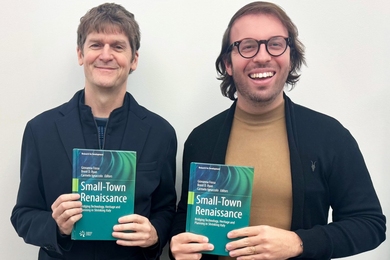An MIT research group headed by Assistant Professor Wolfgang Ketterle has established the latest milestone in the decades-long effort to understand a rare state of matter known as the Bose-Einstein condensate, which was first postulated more than 70 years ago by the Indian physicist Satyendra Nath Bose and Albert Einstein. A Bose-Einstein condensate (BEC) is a mysterious quantum-mechanical state in which matter is coherent and has "laser-like" properties.
BEC was observed long ago in liquid helium and in superconductors, and more recently in semiconductors. A significant stride was taken in June when a team at the University of Colorado led by MIT alumni Eric A. Cornell and Carl E. Wieman first observed BEC in a dilute atomic gas.
The very recent work of Professor Ketterle and his colleagues in the Research Laboratory of Electronics (RLE) and the Department of Physics is expected to allow scientists to move beyond demonstrating BEC to using it to study little-understood quantum mechanical effects.
The team obtained Bose-condensed atoms with a production rate 10,000 times higher than the number obtained in the Colorado experiment, and reported achieving this level in 9 seconds, compared with the several minutes required by devices used in the other experiments. The higher number of atoms involved in the MIT experiment and the brief time required to bring them to BEC are achievements that open the way to studying a state of matter whose properties are not fully known.
In a recent issue, Science magazine headlined the achievement as "A Bigger, Better Bose-Einstein Condensate."
Success came late on September 29, three years after Professor Ketterle started his search for this peculiar state of matter. The keys to the achievement were a special arrangement of laser beams to collect and cool the atoms and a unique magnetic "trap" that kept the atoms from escaping. Professor Ketterle developed the laser-arrangement technique in 1991 and 1992, working with Professor David E. Pritchard of physics and the RLE and collaborators.
The magnetic trap was recently developed by the Ketterle team. The group's paper (published in the November 27 issue of Physics Review Letters) says it "offers a superior combination of tight confinement and capture volume, and the attainment of unprecedented densities of cold atomic gases." The key to the new trap: a tightly focused laser that creates an "optical plug" which keeps atoms from spilling out of the trap. The result: a Bose condensate with about 500,000 sodium atoms, compared with the 2,000 rubidium atoms observed in the Colorado experiment and the estimated 100,000 lithium atoms in an experiment done late this summer at Rice University by a team led by Randall G. Hulet, also an MIT alumnus.
The three groups-MIT, Colorado and Rice-that have observed BEC in atomic gases this summer, all have used a combination of laser cooling and evaporative cooling, the latter method first demonstrated at MIT by Thomas J. Greytak, Harold F. Hess and Daniel Kleppner and their collaborators. They applied this method to atomic hydrogen and held the record for the closest approach to BEC until this summer. Dr. Kleppner is the Lester Wolfe Professor of Physics and associate director of the RLE, Professor Greytak is in the Department of Physics, and Dr. Hess is now at Bell Laboratories.
BEC is achieved by chilling a gas of atoms to such a low temperature that the normal motion of the atoms is suddenly halted and they lose individual identity and display uniform behavior as required by the rules of quantum mechanics. Because of this, scientists believe they may be able to study quantum effects on the rather large scale of several hundredths of a millimeter (atoms are 10,000 times smaller).
In their paper, the MIT researchers said, "BEC is a ubiquitous phenomenon which plays significant roles in condensed matter, atomic, nuclear and elementary particle physics, as well as in astrophysics. The study of BEC in weakly interacting systems holds the promise of revealing new macroscopic quantum phenomena that can be understood from first principles, and may also advance our understanding of superconductivity and superfluidity in more complex systems."
In addition to Professor Ketterle, the authors of the Physics Review Letters paper are Kendall B. Davis (1995 MIT graduate), Marc O. Mewes (fifth-year graduate student), Michael R. Andrews (third-year graduate student), Klaasjan van Druten (postdoctoral associate), Dallin S. Durfee and Dan M. Kurn (both second-year graduate students).
Professor Wieman of Colorado studied under Professor Kleppner and received the SB from MIT in 1973, and Professor Cornell received the PhD from MIT in 1990 for work under Professor Pritchard. Professor Hulet, leader of the Rice team, received the PhD from MIT in 1984 for work under Professor Kleppner.
A version of this article appeared in MIT Tech Talk on November 29, 1995.





